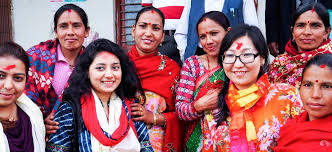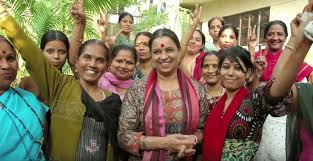The story of the global women’s funding movement deserves to be better known, and this book, The Uprising of Women in Philanthropy, co-authored by nine women leaders, sets out to do just that.
The Global Women’s Funding Movement is a worldwide network of women’s funds that power gender equity and social justice movements with money and resources. Today, women’s funds are typically public, nonprofit funds whose primary purpose is to mobilize funds for work led by women, girls, and gender-expansive persons to advance women’s rights and gender equality. There is also Prospera, the International Network of Women’s Funds, and the Women’s Funding Network.

One of the great catalyzers of creating women’s funds was the UN World Conferences on Women and notably the 1995 World Conference on Women in Beijing. The conference was attended by 17,000 representatives from 189 countries and territories. The power of women’s movements was so evident that women realized they needed to mobilize funding for the causes they cared about. Global Fund for Women and Urgent Action Fund in the United States and International Women’s Development Agency in Australia were all created by founders inspired by their experience at the UN women’s conference in Beijing.
Over the years, several women’s funds have emerged in Asia, including Women’s Fund Asia based in Sri Lanka, Tewa, the Nepal Women’s Fund, South Asia Women Foundation India, Bangladesh Women’s Foundation, HER Fund in Hong Kong, and Urgent Action Fund Asia and Pacific. The stories behind the creation of some of these funds speak to the creativity and determination of the founders. This is undoubtedly true of Tewa, the Nepal Women’s Fund, a story told in The Uprising of Women’s Philanthropy.

In 1995, Rita Thapa envisioned a women’s Fund for Nepal. Thapa explains, “Nepal has an ancient traditional culture of giving which is rooted and ingrained in the fabric of Nepali life whatever one’s religious and cultural background. However, philanthropy, as it is now understood globally or practiced mainly in North America and Europe, is not so prevalent or well understood. It is easy to raise funds to build a temple, a rest house, or even feed those who are hungry. Building a home for abandoned women, elderly people, or orphans is more likely to be understood. But how can one ask for money to support women’s empowerment?”
With Tewa, Thapa set her sights on innovating new fundraising strategies. The program aimed to fundraise locally to help reaffirm that Nepalis themselves could run ‘sustainable’ philanthropic structures in aid-ridden Nepal and avoid the notion of donor dependency. Thapa explains,” This would also help build communities, make philanthropy more relevant to present times and need, and in the process, help restore human dignity.”
Thapa gathered her friends together to share her vision. They asked her, “Who is going to provide the funds? We don’t have money.” Rita took off one of the gold bangles on her wrist and said, “But sisters, we do have these bangles, which belong to us. We can each give a bangle and start from there.” It didn’t take long for Rita to convince many of her vision. Global Fund for Women also believed in Rita’s vision and gave Tewa its first grant. Tewa’s membership grew quickly, and they learned soon after launching that what was needed first was an ’emergency fund’ to respond to women who were in crises with nowhere else to turn. Much later, Rita and her team secured enough funds to buy a building for Tewa to have a secure organizing base for the transformative change it sought to make possible.

This is just one of many stories in The Uprising of Women in Philanthropy that captures the impact of this global philanthropic movement. Collectively, the global women’s funding movement has raised billions of dollars to fuel women’s and feminist movements for justice. It has increased awareness of democratizing philanthropy and the importance of giving women flexible funds – trusting them to know the priorities, strategies, and solutions required in their communities.
As is shared in the book, the story of the global women’s funding movement is not just a stunning success story. It is a story of courage, creativity, community, and tenacity. With a world in crisis due to increasingly frequent pandemics, climate emergencies, civil wars, and conflicts, with the closing space for civil society and the commons, there’s much to despair about. What offers hope is this bold, sassy, and electric movement mobilizing millions in funds for women-led change that has helped end civil wars, combat gender-based violence, increase economic opportunities and save lives by shifting structures, narratives, power, resources, and policies for justice.
The late Ursula Le Guin said, ‘We are volcanoes. When women offer our experience as our truth, as human truth, all the maps change. There are new mountains.”

This movement has trusted women leaders to know the stories and solutions required for bold change and a new world imagined. It has affirmed what Ellen Johnson Sirleaf, Former President of Liberia, has said, “If your dreams do not scare you, they are not big enough.”
The late Wangari Maathai, founder of the Green Belt Movement who inspired the support of women’s funds, said, “In the course of history, there comes a time when humanity is called to shift to a new level of consciousness, to reach a higher moral ground. A time when we must shed our fear and give hope to each other. That time is now.”
This is a story of many women across the globe choosing to give hope to each other and to give a vision of justice through diverse movements. It is the truth that was told by the late Maya Angelou: “Each time a woman stands up for herself, she stands up for all women.”
The Uprising of Women in Philanthropy documents the journey of this philanthropic movement and its investment in a vision, yet to be realized, of every woman, every person living free of violence, equitably sharing power and resources, and honoring diversity, Indigenous wisdom, and practice. A world where biodiversity is restored and where poverty, inequality, and injustice are history. A world where women have full control over their bodies, and all people have freedom of movement, identity, and expression and can realize their full potential.
A world where there is a culture of giving that kindles joy and generosity. As the writer Angela Davis has said, “I think the importance of doing activist work is precisely because it allows you to give back and to consider yourself not as a single individual who might have achieved whatever, but to be part of an ongoing historical movement.”
Disclaimer: The opinions and views expressed in this article/column are those of the author(s) and do not necessarily reflect the views or positions of South Asian Herald, its editorial team, or its affiliates. South Asian Herald does not endorse any opinions or statements made within the content.






